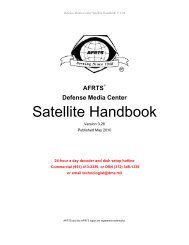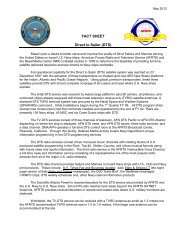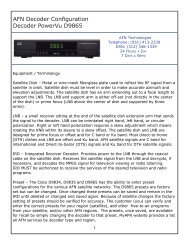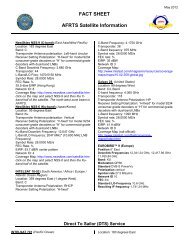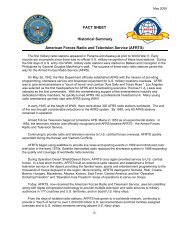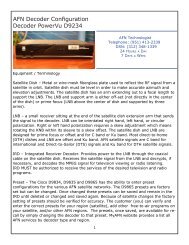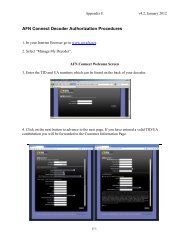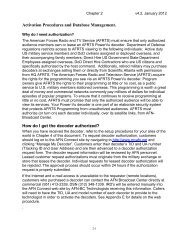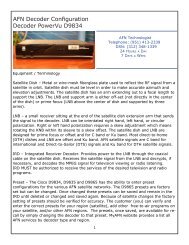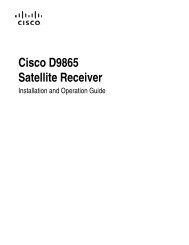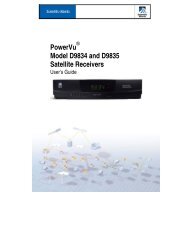Digital Satellite Downlink Reception - American Forces Radio and ...
Digital Satellite Downlink Reception - American Forces Radio and ...
Digital Satellite Downlink Reception - American Forces Radio and ...
You also want an ePaper? Increase the reach of your titles
YUMPU automatically turns print PDFs into web optimized ePapers that Google loves.
Defense Media Center <strong>Satellite</strong> H<strong>and</strong>book V.3.26<br />
from the earth station antenna, with special attention being paid to the<br />
construction, (galvanized steel is preferred).<br />
A wire mesh fence, property constructed, will scatter-back <strong>and</strong> absorb the energy<br />
<strong>and</strong> appear to the interfering signal much like a solid sheet of metal. The<br />
optimum dimension for the mesh fencing is a mesh size smaller than 1.27cm,<br />
(1/2 inch), which offers adequate protection at C-b<strong>and</strong>.<br />
To block ignition impulse noise from a busy street or parking lot, a galvanized<br />
steel fence with a mesh size smaller than 1.27cm (1/2 inch), should be grounded<br />
with copper grounding rods or chemical ground system. The wire fence in<br />
combination with the ground system should accommodate a wide variation of RF<br />
emissions generated from engine ignition systems. Effective fences that have<br />
also been utilized in the past are fine wire mesh <strong>and</strong> solid thin sheet metal<br />
barriers.<br />
Earth Berms<br />
A more drastic but very effective manner to protect from terrestrial interference is<br />
the use of earth berms. Placing the antenna below ground level, while more<br />
costly <strong>and</strong> not always practical, it still provides an excellent manner in which to<br />
protect the integrity of the receiving signal from RFI.<br />
When constructing a “earth berms” careful considerations should be given to the<br />
side lobes of the antenna since the noise temperature of the earth is much higher<br />
than that of the dark sky. The surrounding earth in the earth berms may cause a<br />
noise figure degradation if it is not significantly outside of the antenna side lobe.<br />
Summary<br />
<strong>Digital</strong> Video Compression systems will continue to be the choice for future<br />
satellite video broadcasting because of the b<strong>and</strong>width efficiency <strong>and</strong><br />
unsurpassed video quality. The traditional FM analog approach to earth<br />
station operation will enter a new era with the advent of video<br />
compression. Many video earth station operators are learning the same<br />
sensitivities to RFI as the traditional digital common carriers (IDR)<br />
networks used in the telecommunications industry. Through education of<br />
earth station operators, adaptation to the environment, <strong>and</strong> advances in<br />
technology, digital compression systems will become the st<strong>and</strong>ard in<br />
satellite video broadcast delivery throughout the world. Education <strong>and</strong><br />
underst<strong>and</strong>ing of the effects of terrestrial interference, <strong>and</strong> its prevention,<br />
are the most important steps in achieving the high st<strong>and</strong>ard of service<br />
dem<strong>and</strong>ed by subscribers in the worldwide marketplace.<br />
Table 4-1 Spectrum Analyzer Setup<br />
1. Connect the input of the spectrum analyzer with a T-connector between the LNB <strong>and</strong><br />
the receiver. Caution: This will put 13-19 volts DC on the input of the spectrum<br />
analyzer <strong>and</strong> could damage it. To prevent this from happening use a DC blocker on<br />
4-18



